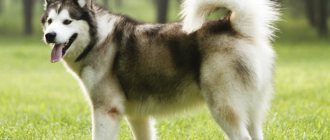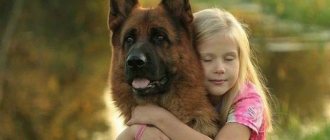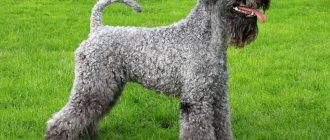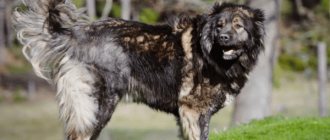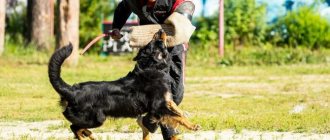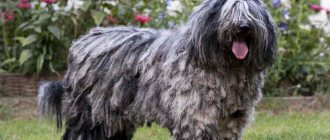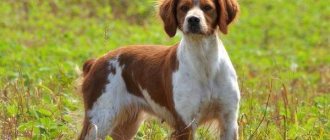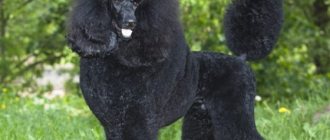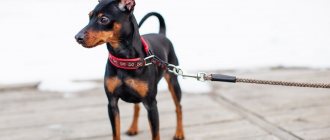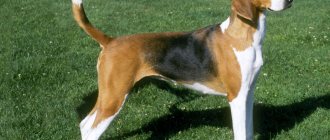The Dalmatian is one of the most charming and peaceful breeds. They stand out on city streets due to their unusual color with black spots. This is a good-natured dog that infects the people around him with positivity and optimism. He is loved for his lack of aggression, high intelligence and devotion to people. It is not recommended to have such a dog as a fashion accessory. For a pet to become a true friend and companion, it must be raised correctly.
Characteristics and description of the breed
This is an energetic, beautiful breed that has gained immense popularity thanks to the famous cartoon. Despite its aristocratic appearance, the large dog was previously used for hunting. Now he is used as a companion dog. Thanks to its good disposition and restraint, the animal gets along well with children.
Aggressiveness
Dalmatians are distinguished by their kindness and devotion. They are loyal friends and enjoy playing with children and other pets. They are not aggressive, but in case of danger they are able to protect a person. The dog will not fawn over a stranger, but will not rush at strangers either. The attitude towards “strangers” is wary and non-aggressive.
Activity
The dog is quite active and requires long walks. It is recommended to keep her in a private home with the possibility of free walking. If the dog does not walk much, he becomes uncontrollable and can cause mayhem in the house.
Training
The dog learns quickly even with an owner who has never trained before. She trusts her owner and enjoys learning new things. The dog remembers learned commands for the rest of his life.
Shedding
Dalmatians shed all year round. The intensity increases in spring and autumn. Breeders consider this one of the disadvantages of the breed.
Need for care
These dogs have almost no smell. Washing is often replaced by wiping with a damp towel so as not to dry out the skin. They also trim nails, comb, and clean eyes and ears.
Friendliness and attitude towards children
The dog gets along well with children and animals in the house. You can safely leave the animal in the same room with a 5-6 year old preschooler. It is better if the puppy and child grow up together.
Health
If properly maintained, the dog rarely gets sick and can live from 10 to 13 years. Diseases of the breed: urolithiasis, dermatitis, allergies.
Attitude towards loneliness
This breed is very attached to people. The long absence of owners leads to melancholy. When a person is constantly busy and cannot give the necessary attention to a pet, the dog “winds up” himself that he is no longer loved.
Maintenance cost
The cost of maintenance varies from 5 to 15 thousand rubles. It depends on the purpose of the purchase (companion dog for home, exhibition, breeding), the animal’s diet (natural dog, food) and other nuances.
Intelligence
The breed is distinguished by high mental abilities. The dog quickly remembers what is happening around him and is trained. He is able to adapt to the mood of the owner and his family members.
Noise
The dog is quite emotional and noisy. She is prone to an active lifestyle. When expressing feelings, he barks a lot and “talks” to people. In the absence of a person, it can howl.
Security qualities
Despite its harmless appearance, this is a dog with a developed guard instinct. In case of danger, it will protect property and people. The dog rarely bites; he scares the uninvited guest more.
Lifespan
A dog can live from 11 to 13 years. The maximum life expectancy reaches 17 years.
General characteristics of the Dalmatian dog breed
These smart, active and cheerful dogs make good companions for active owners. Their memorable appearance attracts attention, and their friendliness and lack of aggression makes it possible for families with children to have such a pet. This is an ancient breed that has been known for several thousand years. But it gained wide popularity in the 60s of the 20th century thanks to the cartoon “101 Dalmatians”. It shows the ideal pet, loyal and intelligent.
The Dalmatian can truly make the best family dog. He loves people, is able to understand their mood and give joy. But for this he needs to be raised correctly. In fact, this dog has a complex independent character. He can be stubborn and requires a lot of attention. Only an experienced dog breeder can raise this dog to be a wonderful companion. And his high intelligence, natural kindness and ability to empathize make him a good rescuer and service dog.
| Options | Characteristic |
| breed name | dalmatian (Dalmatian) |
| country of origin | Croatia |
| year of registration | 1926 |
| group of breeds according to the ICF classification | hounds |
| application | hunting dog, companion |
| life expectancy | 10-13 years |
| height | males 56-62 cm, females 54-60 cm |
| weight | males 27-32 kg, females 24-29 kg |
| character traits | playful, sensitive, cheerful, willful, touchy |
| aggressiveness | non-aggressive, but may be suspicious of strangers |
| attitude towards a person | loyal, need attention, do not tolerate loneliness well |
| intelligence | very smart, easy to train |
| difficulty of care | Sheds a lot, no dog smell |
| activity | very active, energetic, requires physical activity |
What is the correct name of the breed?
The name of the breed comes from the region of Dalmatia on the Balkan Peninsula. But earlier this dog was called Dalmatian dog, brindle dog, Danish hound, harlequin. The modern name did not take hold immediately.
There is still debate as to which is correct: Dalmatian or Dalmatian. The first option is often used. But this can be called a person born in Dalmatia. In relation to the breed, the name Dalmatian would be more correct.
pros
These dogs gained wide popularity not only thanks to the Disney cartoon. This dog really has many positive qualities. If raised correctly, she will be an ideal pet and companion. Dalmatians have the following advantages:
- expressive, attractive appearance;
- good-natured, cheerful character;
- they are sociable and make contact well;
- easy to learn, quick-witted;
- treat children well;
- loyal, affectionate, love people and know how to empathize;
- strong, resilient, can make independent decisions, thanks to which in a dangerous situation they can save the owner’s life;
- live peacefully with other pets;
- balanced, resistant to stress;
- do not show aggression;
- with proper upbringing, it is an easy-going, obedient dog.
Minuses
But the breed is not suitable for everyone. Elderly people, homebodies and those who are away from home for a long time should not have it. This dog is quite large and active, so it is difficult to keep it in a city apartment. She requires constant attention and great physical activity. Those who want to get a Dalmatian need to know its disadvantages:
- noisy, often raises his voice;
- early socialization and strict education are required, otherwise the dog will become uncontrollable;
- you need to walk for a long time, run, without physical activity the dog can destroy the house;
- stubborn, strives to dominate;
- may be vindictive and touchy;
- The fur sheds a lot.
The video will tell you about the pros and cons of these dogs:
Video: Pros and cons of the breed.
Video: Dalmatians: features of the breed.
Video: Dalmatian.
Story
The first mention of this breed is found in ancient Egyptian scrolls. These descriptions are so scarce that it is impossible to understand who the ancestors of exotic dogs were. The most informative and reliable evidence is considered to be the description of Dalmatians in the 15th-16th centuries. These dogs are present in portraits of Venetian artists and frescoes of monasteries.
It is believed that the breed originated from Croatia, and when breeding the breed, black pointers and white English terriers were used. Dalmatians continued to be improved by British breeders and at the end of the 17th century the appearance of modern Dalmatians became recognizable.
It was discovered that the dog does not get tired for a long time and runs, keeping up with horse-drawn carriages. For this reason, Dalmatians were bred to guard property and people during long journeys and journeys. These animals also urged tired or unruly horses.
In England they were called carriage dogs. They were also used as game hunters and to protect society ladies. Dalmatians were considered a sign of the high status of the owner.
In America, Dalmatians have evolved from hunting dogs into alert dogs for firefighters. They signaled that a carriage was moving to extinguish the flames. These dogs are considered the mascot of firefighters in America.
The official breed standard and the first breeders' club were formed in 1890. This breed appeared in Russia in the 80s of the last century. But she still remained rare, the demand for puppies was not so great. The greatest spread of the breed in our country began in the nineties of the 20th century.
Historical origin of the breed
Dalmatian, or Dalmatian, as they are used to calling him in Russia, comes from Croatia. Dogs with an unusual color appeared on the territory of Dalmatia, a historical region on the Balkan Peninsula. But scientists have found that dogs similar to representatives of the breed lived in ancient Greece. They were depicted in numerous drawings. Therefore, there is a possibility that the ancestors of Dalmatians lived several thousand years ago.
Interesting Facts
The Dalmatian is a breed that can be characterized by some features:
- Puppies are white when they are born. The spots that distinguish dogs from other breeds appear later, as they grow older.
- The same gene that causes spotting affects the hearing of animals. Some Dalmatians are partially deprived of it or are recognized as deaf.
- Dogs used to help firefighters do their jobs. They accompanied the cart and ran ahead to announce their approach and scare away citizens. Seeing the dogs, they parted and the road was cleared for passage. While the firefighters were working, the Dalmatians guarded the horses harnessed to the team. They protected them from unscrupulous people who wanted to steal livestock.
Dalmatian
Appearance (breed standards)
The Dalmatian Dog is a large dog with a developed, athletic body and strong limbs. The height at the withers varies from 54 to 62 centimeters, depending on gender. This breed is considered medium in size among other dogs. Representatives of this breed are distinguished by their endurance when running. Their long legs have soft pads that give them good traction on the surface.
- A male Dalmatian weighs from 27 to 32 kg.
- Bitches are slightly smaller, their weight reaches 24-29 kg.
Head
Dalmatians have a proportional head. It is slightly elongated. There are no skin folds on it. The skull is flat, wide between the ears. The transition from forehead to nose is moderate.
Eyes
These dogs have medium-sized eyes, the color of which depends on the color. Individuals with black spots have dark brown eyes. Those with amber spots have lighter eyes.
Ears
The Dalmatian's ears are large and widely spaced. They are triangular in shape and slightly rounded at the ends. The ears are covered with spots in the color of the main color.
Jaws
The jaws are strong and have a scissor bite. The upper row of teeth completely hides the lower one.
Torso
The animal's loin and croup have a slight slope. The dog's body is muscular and well built, the stomach is retracted. The chest is voluminous with long ribs.
Neck
This breed of dog has a long neck with a slight bend. It tapers towards the head.
Tail
The tail has a medium height set. It reaches the hock joint. The tail has a wide base and tapers towards the tip. If the dog is calm, the tail hangs. When the Dalmatian is excited, it rises parallel to the floor (ground).
Paws
The front legs are straight with the elbows pressed to the body. The hind legs are more muscular, with strong knees. The toes are well formed and look like cat paws. The pigment of the claws depends on the color of the animal.
Wool
The animal has shiny, smooth, hard fur. The hair is practically odorless and thick. The dog sheds all year round.
Color
Dalmatians are white with black or brown spots scattered over the body. If the spots have a gray, lemon or other tint, then these dogs are not recommended for exhibitions.
The ideal spot size is up to 3 centimeters. Markings on the body, head and limbs should not merge.
If the dog is tri-colored, it is considered a violation of the breed standard. Such Dalmatians are not allowed to show.
Description of the dog
The Disney cartoon about 101 Dalmatians made these dogs a favorite of many children, as in the film they are presented as very smart, kind and loyal animals.
Important! In fact, Dalmatians require a lot of attention and need strict training, since without education they can be overly aggressive, but if you approach their training with all responsibility, you can raise a good-natured and harmless animal, like in the cartoon.
History of the breed
Dalmatians are rightfully considered to be very ancient breeds of dogs, which is why there is a lot of unknown and unclear things in their history. There are many theories about the country in which these animals first appeared.
According to some scientists, Dalmatians appeared in Dalmatia (historical province of Yugoslavia), where the name of the breed came from. But now in the territory of the former Yugoslavia it is rare to find Dalmatians, and those that exist are most often brought from other countries, which gives reason to believe that the homeland of this breed is not Dalmatia at all.
According to another version, this breed appeared in Ancient Egypt, since rock paintings depicted spotted dogs, which were called ashy. Perhaps these are the ancestors of Dalmatians, since they had a similar color, the same size, body and skull structure, and were also hunting. It is believed that the spotted pattern is not the result of crossing, but a natural pattern that helps the animal hide in a shady area. Dalmatians also love the heat, which also gives reason to believe that Egypt could become the homeland of these animals.
There are still many guesses, opinions and legends about the appearance of this breed. Some of them are quite real, and some are almost impossible to believe. But if we consider all of them, the Dalmatian breed could appear in such countries as:
- Ancient Egypt;
- India;
- Dalmatia (Yugoslavia);
- Austria;
- Greece.
Reference. In all the drawings where similar, spotted dogs were depicted, they were chasing prey, which gives reason to believe that the breed was bred for hunting.
What is the correct name of the breed?
The established name of the breed is Dalmatian, but often in literature and in people’s speech the name “Dalmatian” is found, which is also correct. Throughout the rich history of this breed, a variety of names have been used, such as:
- brindle, or Turkish dog;
- Dalmatian dog;
- Bengal brakk;
- Danish hound;
- harlequin;
- French dog and many others.
Reference. There are many names, but the breed is still one - Dalmatian.
Description of external characteristics
Dalmatians are large, muscular, white dogs with black or brown spots scattered throughout their bodies. The spots are round, clear, and do not merge with each other. The height of an adult male Dalmatian is 56–62 cm, females are 2–3 centimeters less. The average weight of a male is 27–33 kg, and that of a female is 23–29 kg. Dogs' fur is short, hard, and shiny.
The ratio of the length of the muzzle to the length of the skull is one to one. The ears are medium in size, set high, hanging, lying close to the cheeks. The tail is usually carried down and should not curl or stand upright, and in most cases it is pigmented.
There are two types of this breed - black-spotted and brown-spotted. Accordingly, the differences between them are in the color of the spots, nose and eyes. The former have black spots and nose, dark brown eyes, the latter have brown spots and nose, and yellow eyes, but there are also individuals with blue eyes (in some countries this is considered a defect of this breed).
Important! If a dog has both black and brown spots on its body, then it is considered “rejected”, that is, not suitable for participation in competitions.
Lips are not drooping, partially or fully pigmented. The bite is correct, the jaw is powerful, with a set of 42 teeth.
Why was the breed bred?
Initially, dogs of this breed served as hunters. Due to their endurance and subtle sense of smell, they were able to cover vast territories in search of prey.
In the 17th century, due to their bright appearance and good instincts, Dalmatians began to be allowed in front of carriages so that they could warn their owners in case of danger on the road (most often this concerned robbers who robbed carriages). Then they began to be allowed between the rear wheels or even under the carriage, so their height did not exceed 60 centimeters. At that time, Dalmatians were called carriage dogs.
In the 19th century, dogs of this breed served in the fire department. They ran ahead of the fire carriage barking loudly, warning people of the danger. They had a small helmet placed on their head, which distinguished fire dogs from domestic dogs.
Many of them performed in circuses, although there is an opinion that it is very difficult to teach them complex commands and tricks.
Reference. For some time, Dalmatians acted as shepherds and rat catchers.
Character
The dog is active and friendly. She is quite capricious, but not aggressive. Many breeders note the dog's charm, artistry and charisma. This is a peace-loving dog and if raised correctly from early childhood, it will not be aggressive or disobedient.
Dalmatians are companion dogs. They have a hard time withstanding loneliness and are ready to be with their owner all the time. If he is given little time, he gets upset and offended. This is a dog with a strong guard instinct. Despite its friendliness, in case of danger the dog will rush to protect its owners and property.
He easily gets along with other animals in the house if he grows up with them. But on walks, the dog can quarrel with males of other breeds in the struggle for leadership and territory.
Breeders do not recommend keeping two male Dalmatians in the same apartment or house.
Spotted dogs try to treat all people in the house equally, without singling out the “pack leader.” You should carefully monitor the animal when leaving it in the same room with a small child. The dog is very active, sharp and impetuous in its movements. He can, without noticing, sweep the baby off his feet.
You should not approach the animal from behind, so as not to scare it. In this case, the dog may instinctively show aggression.
Mating, pregnancy and childbirth
Experts do not recommend breeding a Dalmatian Dog during the female's first heat. Ideally wait for the third one. Moreover, this cannot be done on any day; it is better to introduce the dogs a week or two after the start of estrus. You don’t need to feed them before this, but you do need to take them for a walk. Moreover, the dog and the bitch should spend time together and get used to each other. And then they themselves will figure out what to do next. After a day, a maximum of two are advised to carry out a control mating.
Pregnancy becomes noticeable after about five weeks. The dog may show signs of toxicosis. She will become calmer and more affectionate. Delivery usually occurs after 65-70 days. The Dalmatian breeds a large number of offspring, with an average of 10-14 puppies. Moreover, they are all very viable.
Offspring
Application
As society developed and progressed, the functions of dogs changed. They have hunting skills, a developed guard instinct and are devoted to people.
- Initially, Dalmatians were used to guard cargo during travel. They urged stubborn horses. A pack of such dogs could even cope with large wild animals that stood in the way.
- In addition, Dalmatians were used as hunting dogs and for herding livestock.
- In America, white spotted animals were perceived as a warning about the movement of the fire brigade. Until now, in this country they are a mascot for firefighters.
- Currently, the breed is bred as a companion dog. It is ideal for a large family with children.
The purpose and character of the Dalmatian
Dalmatians have a very multifaceted character. They tend to be dominant, so from puppyhood it is very important to train the dog and show who is boss. You should not indulge in even cute-looking pranks, otherwise in the future the Dalmatian will simply sit on your neck. They are very family dogs, social and curious. They don’t lie quietly on the rug, but poke their noses everywhere. If you drive them away without paying due attention, they begin to behave badly - they chew furniture, shoes, and throw things around. In a word, Dalmatians should always be with you and at work, that’s why they are companions.
These dogs have a lot of natural strength and power. They are simply tireless revelers and require prolonged daily exercise. They will be happy to play, run next to the owner's bicycle, and go to the mountains. Lack of physical activity affects behavior and then health. Keeping it in an enclosure or in an apartment without frequent long walks is absolutely not suitable.
They also have such a negative character trait as vindictiveness. Try to be fair with your pet, do not offend him, be sensitive to his needs. The Dalmatian is a proud dog, it does not tolerate familiarity and, on occasion, can take revenge for disrespect.
Despite their hot temperament, Dalmatians are quite silent; they bark only when necessary. They behave with restraint with strangers and do not show aggression. They are considered good nannies and companions for children. There are many cases where Dalmatians protected and protected their little charges - in this case, the dog considers itself to be in charge and is responsible for the value entrusted to it.
1 of 7
Maintenance and care
Despite its rather large size, the animal can live in an apartment provided it takes long daily walks. The Dalmatian moves carefully, without destroying anything in its path. He will not, being capricious, spoil things in the house. Breeders claim that the best housing option would be a country house with a large yard where the animal can run freely.
The dog is very active and will need to be walked a lot. The dog will be happy to go jogging with its owner and accompany him when riding a horse or bicycle. It connects to walking tours around the city and trips to the park and forest.
Nutrition
For your dog's health, it is necessary to choose a balanced diet. Food should not be cold or hot. You should ensure its freshness and do not overfeed your dog. If there is food left in the bowl, then reduce the portion. The owner himself chooses to feed the pet with natural food or food.
Food for this breed of dog is not salted. To restore the water-salt balance, it is enough to occasionally give your pet salted cheese or fish.
Prohibited products:
- pork;
- bones;
- salt;
- spices;
- smoked meats;
- bakery.
Authorized products:
- raw meat (lamb, veal, chicken, rabbit);
- offal (udder, liver);
- lean sea fish;
- fermented milk products (cottage cheese, kefir, yogurt);
- cereals (buckwheat, rice);
- zucchini, cabbage, potatoes, pumpkin;
- vegetable oil;
- apples, citrus fruits.
Hygiene
Shedding in this breed of dog is not seasonal, but year-round. The dog must be brushed daily or every other day with a soft brush. Dogs often have allergies. From time to time, the skin is examined for inflammation, peeling, irritation and parasites. The dog likes the touch of people and will gladly allow itself to be brushed.
- The snow-white coat rarely gets dirty, because the animal is quite clean. It will not lie in a puddle and dust.
- Dogs are washed several times a year using a special dog shampoo. The dog has practically no smell, so it can be wiped with wet wipes.
- The Dalmatian's ears are large, which means they often get dust and dirt. When they become dirty, wash them with warm running water.
- Eyes also need to be washed to prevent conjunctivitis and tearing.
Health and illness
Basically, Dalmatians have strong immunity and health. If the dog is properly cared for, then as it grows and ages, it will not develop chronic diseases. Deafness is considered the main congenital pathology.
About 30% of Dalmatians have hearing problems, and 12% of puppies are born deaf. Despite the fact that only healthy dogs are bred, deafness can also occur in their offspring.
Main diseases of the breed
- Urolithiasis and kidney disease can occur at any age. They usually develop due to poor nutrition. The animal's lower back begins to hurt. The dog does not allow its owners to pick it up, touch its back, lift it, or pet it in this area. At the same time, the outflow of urine worsens, and the dog begins to move less. As a preventive measure, it is recommended to give the dog more water and maintain its physical activity.
- Pyoderma. An abscess forms on the affected area of the skin, around which hair loss begins. Basically, pyoderma develops when the immune system deteriorates or during prolonged stress.
- Dermatitis. Predisposition to the disease is genetic. The main symptom: skin irritation, redness, peeling. Dermatitis is provoked by allergic reactions to parasite bites, household chemicals or food.
- Demodecosis. This disease occurs due to infection by ticks. The dog begins to lose hair; you can feel a lump on the skin. The dog itches often.
You should not self-medicate your pet. If the above symptoms occur, you should contact a veterinarian who will diagnose the disease, identify its root cause and prescribe treatment.
Mating
When mating, it is important to introduce the male and female dogs on neutral territory. Then the lady is brought to the male. It is best to plan conception on the 9-14th day from the date of the onset of estrus. When knitting, the freestyle method is used. For the first time, dogs may need human help.
The average duration of pregnancy is from 60 to 64 days. One litter can produce both puppies with black and brown spots.
Walks
The dog moves a lot and needs constant physical activity. If you keep your pet in an apartment, you should walk your pet for two hours a day. You can combine this time with cycling or skiing. It is better to walk the dog in a deserted park, in a vacant lot near lakes or in a forest.
Dalmatians enjoy catching the plate and learning agility or flyball.
Health and disease of Dalmatians
With proper care, Dalmatians can live 10-12 years. It is necessary to carry out vaccinations, treatment against parasites and preventive examinations in a veterinary clinic on time. Their health is generally good, but they are predisposed to certain diseases:
- Atopy is an allergic skin reaction; it is a form of hypersensitivity to allergens that can cause allergic reactions.
- Entropy - inversion of the eyelids is common, especially after severe injuries and inflammatory processes.
- Bloating can have several causes, most often due to improper care and feeding.
- Glaucoma – leads to extremely high pressure inside the eye. With this pathology, the outflow of intraocular fluid is impaired, and the eye itself enlarges.
- Joint dysplasia – characterized by unbearable pain, lameness and immobility.
- Distichiasis is a developmental anomaly in which an additional row of eyelashes appears behind normally growing ones.
- Pannus is a superficial keratitis.
- Polyneuropathy is paresis of the hind limbs in dogs.
- Pododermatitis or interdigital dermatitis is an inflammatory disease that affects all layers of skin in the folds between the animal's toes, on the pads of the paws and around the claw. Sometimes the process spreads to hair-covered areas of the upper surface of the paws. The disease can cause significant discomfort to the dog, to the point where the animal begins to limp.
- Demodicosis is a parasitic disease. Caused by microscopic mites of the genus Demodex, which feed on skin and loose fiber. The disease usually spreads from April to September.
- Progressive retinal atrophy is the degeneration of visual cells in the retina of the eye.
- Cataract – the transparency of the lens of the eye decreases and due to its cloudiness, light cannot pass to the retina.
Particular attention should be paid to urolithiasis. Representatives of the breed are especially predisposed to it. The fact is that these dogs have significantly higher uric acid levels than other breeds. Because of this, urine blockage often occurs. A diet in which the dog’s diet will have a reduced protein content will help prevent and prevent the development of urolithiasis.
Dalmatians have one more feature regarding health, we are talking about congenital deafness. It affects 10-12% of puppies. Therefore, before buying a puppy, be sure to check it for deafness, otherwise you risk raising a pet who cannot hear anything, this is very difficult.
Training and education
A puppy begins to be raised from an early age. He quickly learns and remembers commands. At 4 months, the Dalmatian should be able to walk on a leash and know his name. From 5 months it is recommended to move on to more complex commands.
The dog is interested when tasks are constantly different, and when they are completed they receive encouragement.
This breed listens to humans, but they need to be motivated. When training, you should not shout at the animal or hit it.
Grooming
Although the dog's fur is short, it sheds constantly. Puppies move quickly around the house, so tufts of hair quickly spread throughout the apartment. It is better to comb the animals daily. A medium-hard brush will do. A soft one will not cope with the task, and aggressive scratching can damage your pet’s skin.
You won't need to wash your puppy often. After all, even during a walk he behaves carefully, avoids puddles and does not jump into the mud.
Note! A Dalmatian puppy is a clean dog, which greatly simplifies the owner’s task when caring for him.
Pros and cons of the breed
Like any breed, Dalmatians have their pros and cons. Owners who know their dogs very well try to talk only about the positive aspects of the animal’s character, but not everything is so simple.
Advantages of the breed
- high intellectual abilities
- lack of aggression;
- guard skills;
- love for children;
- endurance;
- ease of care;
- cleanliness;
- no smell.
Disadvantages of the breed
- constant shedding;
- not suitable for beginners;
- requires a lot of time and attention;
- difficulties with education and training;
- stubbornness.
Character and intelligence
Cairn Terrier: description of the breed, character of the dogs
Characteristics of the Dalmatian breed will be incomplete without a description of its temperament and lifestyle. This is a fairly friendly and playful dog, but at the same time willful. She becomes attached to her owner and becomes a good friend for him.
Attitude towards children and others
The Dalmatian gets along well with children. He never deprives them of attention; on the contrary, he may even bore the kids. Treats strangers with caution. If he is offended, he will remember and retain the experience for a long time. Therefore, not all people are able to find an approach to the Dalmatian. This is best achieved by those who have already had experience raising dogs.
Photo
How to choose a puppy
You should choose a Dalmatian puppy between one and two months of age. It is best to buy a dog from a trusted kennel. Usually owners choose male dogs to avoid troubles with heat. But such a puppy will require much more time, as it is more active. If he is not raised properly, a large dog will turn the whole house upside down when left alone.
When buying a teenager, the owner must take into account that the dog’s character has developed and he needs to find an approach to him.
Diet
Meat is the basis of the diet.
An ordinary Dalmatian, like a dwarf Dalmatian, must eat properly and therefore it is necessary to understand the diet for such dogs in advance.
You can feed your dog the following foods:
- Meat. All dogs are carnivores and therefore need to be fed meat regularly. Moreover, it should be one third of the daily food intake.
- Cereals. The dog's menu must include cereals. It could be buckwheat, oatmeal or rice. Cereals promote the growth of puppies and also improve the functioning of the gastrointestinal tract.
- Vegetables. To ensure that dogs always have enough vitamins, they need to be regularly fed vegetables. Dalmatians easily digest cabbage, peppers, beets, zucchini, carrots and pumpkin.
- Fish. Several times a month, instead of meat, pets are given fish. At the same time, only sea fish can be given raw. River fish must first be boiled and the bones removed.
Additional Information! Dalmatians love fruit. Several times a week they can be given sliced apples, pears or apricots.
Price
The price of a puppy depends on the characteristics and pedigree of the dog. For an animal without documents, the cost varies from 4,000 to 8,000 rubles. Based on individual characteristics and the breed standard, the price starts from 15,000 rubles and reaches $1,000 or more.
Where to buy a puppy in Russia?
- Nursery in the Moscow region Symphony of stars (https://dalmatin-stars.ru/).
- The Auroras Moon nursery operates in the Krasnodar region (https://aurorasmoon.ru/).
- The nursery “From the Nevskie Islands” is located in St. Petersburg. It is the only specialized breed nursery in the city. (https://dalmatian-spb.ru/pitomnik.htm).
Choosing a puppy
Before you buy such a dog, you need to familiarize yourself with its cost. You can buy a puppy in Russia for 10-15 thousand rubles. The difference in the cost of adult dogs and puppies is small and is about 5,000 rubles (prices are current for August 2020).
There are several recommendations that will help you choose the right puppy:
- the selected dog should not be older than one and a half months, since this age is ideal for starting life in another family;
- Before purchasing, you must carefully examine the dog and make sure there are no signs of disease;
- It is better to buy puppies in specialized nurseries, and not from private sellers.
Additional Information! After purchasing the dog, you must immediately give it a nickname. Many people call Dalmatian puppies Jacquard, Harlequin, Jade or Handsome.
